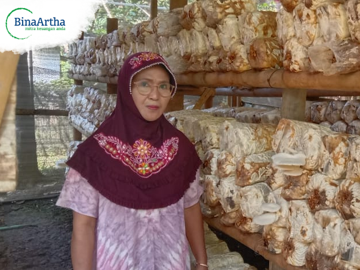Recent reports reveal overwhelmingly positive impact of microfinance
Spreading like mushrooms – the rise of financial inclusion

The mushroom beds of Central Java may seem like an odd starting point when discussing the state of global finance. But within them is an example of what can happen when investors, financial institutions and individual entrepreneurs come together. Take Sugiyani, a female entrepreneur, who has been growing and selling oyster mushrooms for the last eight years. Despite growing demand and a proven track record, obtaining the finance she needed proved elusive for many years. This in turn limited her ability to hire people, increase her family’s income and contribute to the local economy.
Her story is mirrored by hundreds of millions of others who struggle just to get a loan or a bank account, nearly all of them in the developing world. But even though financial inclusion is also frequently referenced in the Sustainable Development Goals (SDGs 1, 5, 8 and 9), its status as a developing world-only issue means that it often doesn’t get the attention that it deserves. This is despite the fact that financial inclusion supports small businesses (a key engine of job creation in developing countries), enables excluded parts of the population (notably women), provides a safe space for saving, and builds resilience via insurance, savings or access to emergency loans. Financial exclusion, however, falls almost exclusively on those the SDGs are designed to help – low-income communities, often in rural areas, women and minorities.
Lack of attention, however, hasn’t stopped progress. A recent World Bank survey, the Global Findex 2021, showed that despite rising populations, the total number of adults without a bank account fell from 1.7 billion to 1.4 billion between 2017 and 2021. In ten years, account ownership increased by 50%. Moreover, the gender gap in account ownership in developing countries fell from 9% to 6%. Interestingly, the survey pointed to mobile banking as a major driver for financial inclusion, especially in sub-Saharan Africa, a development no doubt catalyzed by the pandemic.
This is not to say there are not challenges remaining. 1.4 billion adults still represents a significant share of the world’s population, many of them in areas that are harder to reach (rural areas, fragile states etc.). And while 6% may not sound so bad, this is only a global average, with 37 countries showing greater than 10%. The report also notes the negative effects in terms of resilience for those without access to a financial institution, with many respondents struggling to access a loan in the event of an individual or macro shock.
The frontline in this battle is manned by microfinance institutions (MFIs), which focus on these excluded populations. While a small number of MFIs have been the targets of criticism, there is solid evidence of the positive impact of microfinance and the important role that it plays in contributing to financial inclusion. A recent report by 60 Decibels surveyed the clients of 72 MFIs in 41 countries. 58% were accessing a loan for the first time (65% for women), one in three reported a “very much improved quality of life”, while three quarters of female borrowers with businesses reported that their income had increased as a result of their loan.
In summary, while the trend is positive, and the impact clear, there is still significant demand to be met. And as with the developed world, this can only come with investment. Access to finance in the developing world has been driven, in part, by a growing number of impact investing products that seek to directly contribute to financial inclusion by helping MFIs to expand and reach more customers. But we are now at the midpoint between when the SDGs were created (2015) and when their endpoint arrives (2030). We must not forget that financial inclusion remains an important component in achieving these goals.

As for Sugiyani and her mushroom business, in 2020, despite the pandemic, she finally received her first loan from Bina Artha, a local MFI that specifically targets women in rural Indonesia. In her own words: “With the capital provided by Bina Artha… I bought more materials to create the backlogs for the mushrooms and added additional shelves to produce them. It is very clear that my business growth was only possible with the help of Bina Artha.” She is just one of the 300 million people who gained access to finance in the last four years. Can we reach another 1.4 billion in the next eight years? Imagine if all those people were able to grow like Sugiyani and her mushrooms. It might be a small or even life-changing impact for each individual, but it certainly means massive positive impact as a collective. Financial inclusion, SDGs or no, deserves your attention.

Paul Hailey
Paul Hailey is Head of Sustainability and Impact at responsAbility Investments and the author of various publications and articles. Previous roles at the company include Senior Research Analyst for the financial sector. He has an MBA from École des Hautes Études Commerciales de Paris (HEC Paris), where he is also a lecturer, and a B.A. (Hons) from Pembroke College, University of Cambridge.